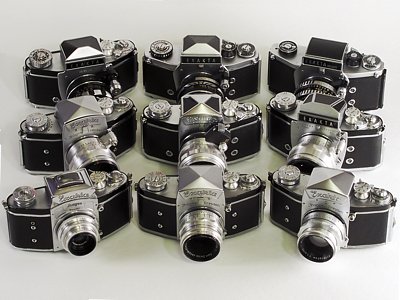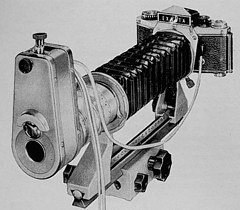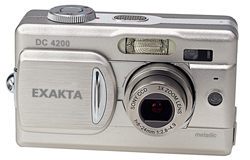More than sixty years ago, a milestone in camera making happened: Ihagee, a Dutch-owned camera company in Dresden, Germany (already known for SLR models in larger format) introduced the first single lens reflex model using the 35 mm film. The world of photography was never the same.
The camera, named just Exakta (and usually referred to as Kine Exakta), was released in 1936. It bore a strong resemblance to the Exakta VP series of the early Thirties, which were using the now-forgotten 127 film to take pictures 40x75 mm in size.
The maker, Ihagee Kamerawerk from Dresden was not a newcomer to the camera manufacturing. Being in this business since 1912, they had a series of successful models, including, in addition to the VP series mentioned above, ones with great-sounding names as Patent-Klappreflex (1924), Luxus-Roll-Paff-Reflex (1927), or Nachtreflex (1930). Still, none of these constructions were as ground-breaking and trend-setting, as the Kine Exakta, whose impact can be clearly felt even today.
The production was almost entirely suspended during most of the war, and then the factory was destroyed in the Allied bombings. Finally Dresden fell into Soviet hands, to become a part of the "worker's paradise", known as the DDR.
In spite of all that, the manufacturing was resumed in late 1945, at first from the pre-war parts; it reached pre-war levels as soon as in 1947. In 1949 the first post-war model, Exakta II, was introduced, and other models followed shortly.
The Fifties were the golden years of the Exakta family. The camera faced no serious competition. It was technologically up-to-date, offered a vast array of compatible lenses and other accessories, the German craftsmanship was still hard to match (it took 20 years of the Communist system to degrade it), and Ihagee could sell as many as they wanted: most of them to the Western Europe and the U.S., and any surplus — to other members of the Soviet-dominated family of nations.
The last "genuine" Exakta, VX500 (by "genuine" I mean made by Ihagee and accessory-compatible with the whole line) was released in 1969. Then the factory was incorporated into the "People's Enterprise Pentacon", and the Exakta label was put on the RTL 1000 — a completely different camera (Practica VLC), not made by Ihagee, and having nothing to do with the previous Exakta models (except for the lens compatibility). The camera was not reliable and did not sell well, so the effort was doomed, and the Exakta line withered out.
On another front, for some time in the 70's the original owners of Ihagee were trying to make their own cameras with the Exakta label in West Germany or in Japan, but these efforts were also largely unsuccessful: the West-German model (Exakta Real), in spite of technical excellence, was not competitive in terms of price, and the Japanese ones were just other bottom-drawer cameras with an Exakta logo (and, initially at least, Exakta lens mount).
By that time the major Japanese camera makers got their act together and within a few years swept any European (or American) competition off the camera market — not just the East Germans. While through most of the Fifties Japanese cameras were cheaper look-alikes of European models, in the Sixties they were able to stand on their own, and in the Seventies became a tough act to follow. The Japanese success was well-deserved.
Exakta was an early victim, unable to compete in terms of design, features, innovation, quality, or price, and beaten into the ground by the incompetent Communist management.
|
Exa — the little sister
|
Exakta was a very expensive camera in those days. This might have been a reason why in the early Fifties Ihagee introduced its scaled-down sibling: Exa. This really was a different camera, but it fit into the system by accepting Exakta's lenses and interchangeable viewfinders.
Exa was smaller, much simpler mechanically and, obviously, quite limited in capabilities compared to its big sister. It also cost, as I remember, less than one third of what Exakta did. It could be used as an introductory camera (although at its price more advanced ones were already available) or as a second body for an Exakta-based system.
The original Exas had a funny shutter of which the mirror was a functional part, and the speeds were very limited: from 1/25 to 1/150s (sometimes 1/175, what a German hairsplitting accuracy!). Only in the Sixties a regular, cloth focal-plane shutter was introduced in Exa II (but this one did not have interchangeable finders). The "funny shutter" models do not work quite right with Exakta lenses of focal length above 100 mm because of horizontal vignetting. This limitation also disappeared in later models.
The "real" Exa series continued up to the Seventies; cameras with this brand name made after 1977 did not share the Exakta bayonet mount and were made quite shabbily, aiming at the bottom of the market. Too bad.
|
Name — just a commodity?
| |



